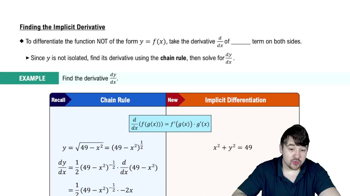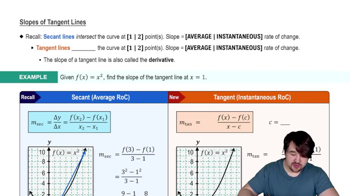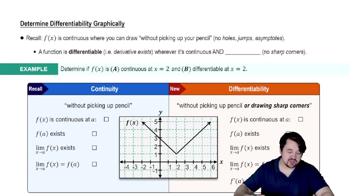Table of contents
- 0. Functions7h 52m
- Introduction to Functions16m
- Piecewise Functions10m
- Properties of Functions9m
- Common Functions1h 8m
- Transformations5m
- Combining Functions27m
- Exponent rules32m
- Exponential Functions28m
- Logarithmic Functions24m
- Properties of Logarithms34m
- Exponential & Logarithmic Equations35m
- Introduction to Trigonometric Functions38m
- Graphs of Trigonometric Functions44m
- Trigonometric Identities47m
- Inverse Trigonometric Functions48m
- 1. Limits and Continuity2h 2m
- 2. Intro to Derivatives1h 33m
- 3. Techniques of Differentiation3h 18m
- 4. Applications of Derivatives2h 38m
- 5. Graphical Applications of Derivatives6h 2m
- 6. Derivatives of Inverse, Exponential, & Logarithmic Functions2h 37m
- 7. Antiderivatives & Indefinite Integrals1h 26m
- 8. Definite Integrals4h 44m
- 9. Graphical Applications of Integrals2h 27m
- 10. Physics Applications of Integrals 2h 22m
4. Applications of Derivatives
Implicit Differentiation
Problem 3.8.91
Textbook Question
90–93. {Use of Tech} Work carefully Proceed with caution when using implicit differentiation to find points at which a curve has a specified slope. For the following curves, find the points on the curve (if they exist) at which the tangent line is horizontal or vertical. Once you have found possible points, make sure that they actually lie on the curve. Confirm your results with a graph.
x²(3y²−2y³) = 4
 Verified step by step guidance
Verified step by step guidance1
Start by differentiating the given equation implicitly with respect to x. The equation is x²(3y²−2y³) = 4. Use the product rule for differentiation, which states that if you have a product of two functions u(x) and v(x), then the derivative is u'(x)v(x) + u(x)v'(x).
Differentiate the left side of the equation: For x²(3y²−2y³), let u = x² and v = 3y²−2y³. The derivative of u with respect to x is 2x, and the derivative of v with respect to x involves implicit differentiation: d/dx(3y²−2y³) = 6y(dy/dx) - 6y²(dy/dx).
Apply the product rule: The derivative of x²(3y²−2y³) is 2x(3y²−2y³) + x²(6y(dy/dx) - 6y²(dy/dx)). Set this equal to the derivative of the right side, which is 0, since the derivative of a constant (4) is 0.
To find points where the tangent line is horizontal, set dy/dx = 0 and solve the resulting equation for x and y. This will give you the conditions under which the slope of the tangent is zero.
To find points where the tangent line is vertical, identify where the expression for dy/dx becomes undefined. This typically occurs when the denominator of the expression for dy/dx is zero. Solve for x and y under these conditions, and verify that these points lie on the original curve by substituting back into the original equation.
 Verified video answer for a similar problem:
Verified video answer for a similar problem:This video solution was recommended by our tutors as helpful for the problem above
Video duration:
9mPlay a video:
Was this helpful?
Key Concepts
Here are the essential concepts you must grasp in order to answer the question correctly.
Implicit Differentiation
Implicit differentiation is a technique used to differentiate equations where the dependent and independent variables are not explicitly separated. Instead of solving for one variable in terms of the other, we differentiate both sides of the equation with respect to the independent variable, applying the chain rule as necessary. This method is particularly useful for finding derivatives of curves defined by equations that cannot be easily rearranged.
Recommended video:

Finding The Implicit Derivative
Tangent Lines and Slopes
The slope of a tangent line to a curve at a given point represents the instantaneous rate of change of the curve at that point. A horizontal tangent line indicates a slope of zero, while a vertical tangent line suggests an undefined slope. To find these points, we set the derivative equal to zero for horizontal tangents and check where the derivative does not exist for vertical tangents.
Recommended video:

Slopes of Tangent Lines
Graphical Confirmation
Graphical confirmation involves plotting the curve and visually inspecting the points where the tangent lines are horizontal or vertical. This step is crucial as it helps verify the analytical results obtained through differentiation. By comparing the calculated points with the graph, one can ensure that the identified points indeed lie on the curve and accurately represent the behavior of the function.
Recommended video:

Determining Differentiability Graphically

 5:14m
5:14mWatch next
Master Finding The Implicit Derivative with a bite sized video explanation from Nick
Start learningRelated Videos
Related Practice


